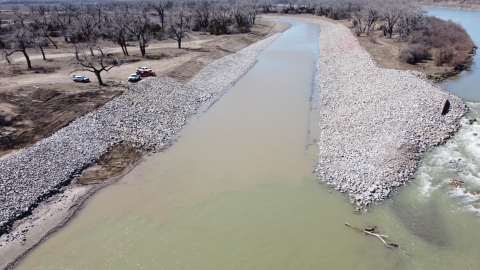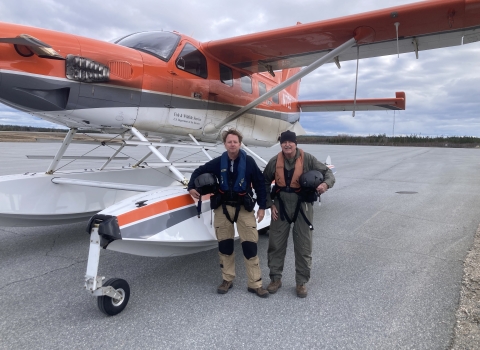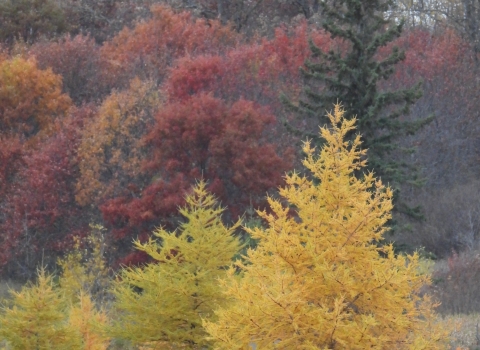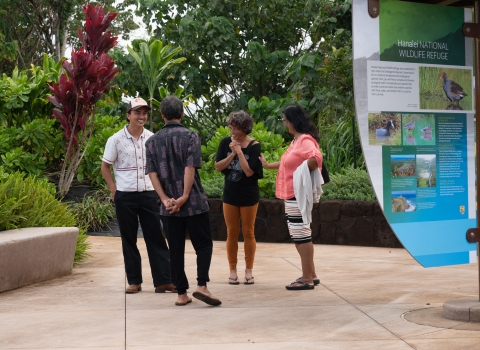This success story is anything but vanilla! After more than two decades of teamwork, an alliance to open new waters for endangered pallid sturgeon on the Lower Yellowstone River finally came to fruition in April 2022, and the results are optimistic. In the first month alone, a total of 9 pallid sturgeon (3 wild and 6 hatchery-raised) have already moved upstream into the expanded territory.
In the late 1990s, the U.S. Bureau of Reclamation (BOR) began discussing the potential effects of the Lower Yellowstone River Project on the federally listed pallid sturgeon with the U.S. Fish and Wildlife Service (USFWS). Data indicated that the weir (aka a low-head dam) used to divert irrigation water was a barrier for migrating sturgeon, which limited upstream access and resulted in too short of a river reach for the species to meet its life history needs.
Queue fish passage fish passage
Fish passage is the ability of fish or other aquatic species to move freely throughout their life to find food, reproduce, and complete their natural migration cycles. Millions of barriers to fish passage across the country are fragmenting habitat and leading to species declines. The U.S. Fish and Wildlife Service's National Fish Passage Program is working to reconnect watersheds to benefit both wildlife and people.
Learn more about fish passage experts to the rescue...
To help these fish get to the river, BOR proposed an in-canal fish screen for the main irrigation diversion and a constructed bypass channel at the diversion dam site. A fish screen is a man-made structure structure
Something temporarily or permanently constructed, built, or placed; and constructed of natural or manufactured parts including, but not limited to, a building, shed, cabin, porch, bridge, walkway, stair steps, sign, landing, platform, dock, rack, fence, telecommunication device, antennae, fish cleaning table, satellite dish/mount, or well head.
Learn more about structure that helps prevent fish from entering waterways where water is taken for human use. However, during evaluation biologists raised concerns regarding the adequacy and efficiency of the initial bypass channel.
Back to the drawing board.
In 2005, a Memorandum of Understanding was developed to formalize the commitment among partners on development of adequate fish passage alternatives. Partners included U.S. Army Corps of Engineers (USACE), BOR, USFWS, Montana Fish Wildlife and Parks, and The Nature Conservancy. Initially, it was decided that the two best solutions were removing the dam and moving the canal intake upstream or developing a full channel width rock ramp. To make sure these alternatives and the fish screen worked, USFWS developed a review team that worked alongside the design engineers to provide recommendations as the designs were being created. This ensures the designs will work throughout the creation process rather than having to start all over again if the design didn’t work. This is some top-notch thinking if you ask us!
USFWS then established a team of pallid sturgeon experts to review fish protection design options for the Lower Yellowstone River Irrigation Project and provide input to engineers to ensure biological requirements for the sturgeon were met. The fish screens were constructed in 2012 to prevent fish losses into the canal. However, serious design concerns were identified in the two initial upstream passage options and all agreed a bypass channel would be a viable solution.
Over the next decade the team met with USACE and BOR engineers as new designs were completed, and efforts were initiated to fund and build the project. In April 2022, the USACE and BOR finalized construction of the bypass channel and within days a tagged pallid sturgeon was documented passing through the channel on its migration to locales upstream. This initial usage is a win for pallid sturgeon and a testament of what agencies can do when they work towards a common goal.





